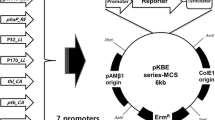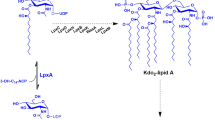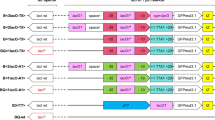Abstract
Genetic studies of Ochrobactrum anthropi, a bacterial species important in bioremediation and biopesticide degradation, are hindered by the lack of suitably regulated gene expression system. A tightly regulated gene-expression system was developed for O. anthropi using the lacIq gene and a re-engineered coliphage T5 promoter containing completely symmetrical DNA segment that binds more efficiently to the lactose repressor. The β-galactosidase activity was increased 57-fold when the expression of the re-engineered T5 promoter was induced. The degree of induction was controllable by varying the concentration of inducer isopropyl-β-d-thiogalactopyranoside.




Similar content being viewed by others
References
Seleem MN, Ali M, Boyle SM, Mukhopadhyay B, Witonsky SG et al (2006) Establishment of a gene expression system in Ochrobactrum anthropi. Appl Environ Microbiol 72:6833–6836
Ozdemir G, Ozturk T, Ceyhan N, Isler R, Cosar T (2003) Heavy metal biosorption by biomass of Ochrobactrum anthropi producing exopolysaccharide in activated sludge. Bioresour Technol 90:71–74
Sadler JR, Sasmor H, Betz JL (1983) A perfectly symmetric lac operator binds the lac repressor very tightly. Proc Natl Acad Sci USA 80:6785–6789
Sambrook J, Fritsch EF, Maniatis T (1989) Molecular cloning. A laboratory manual. Cold Spring Harbor Laboratory Press, New York
Seleem M, Rajasekaran P, Ali M, Boyle SM, Sriranganathan N (2008) Simple method for transformation of Ochrobactrum anthropi. World J Microbiol Biotechnol 24:2111–2114
Seleem MN, Vemulapalli R, Boyle SM, Schurig GG, Sriranganathan N (2004) Improved expression vector for Brucella species. Biotechniques 37:740, 742, 744
Seleem M, Ali M, Abd Al-Azeem MW, Boyle SM, Sriranganathan N (2007) High-level heterologous gene expression in Ochrobactrum anthropi using an A-rich UP element. Appl Microbiol Biotechnol 73:1123–1127
Adhya S, Gottesman M (1982) Promoter occlusion: transcription through a promoter may inhibit its activity. Cell 29:939–944
von Gabain A, Bujard H (1979) Interaction of Escherichia coli RNA polymerase with promoters of several coliphage and plasmid DNAs. Proc Natl Acad Sci USA 76:189–193
Seleem MN, Ali M, Boyle SM, Sriranganathan N (2008) Vectors for enhanced gene expression and protein purification in Salmonella. Gene 421:95–98
Author information
Authors and Affiliations
Corresponding author
Rights and permissions
About this article
Cite this article
Alqublan, H., Seleem, M.N., Boyle, S.M. et al. Tightly Regulated Expression Vectors for Ochrobactrum anthropi . Curr Microbiol 60, 242–247 (2010). https://doi.org/10.1007/s00284-009-9532-6
Received:
Accepted:
Published:
Issue Date:
DOI: https://doi.org/10.1007/s00284-009-9532-6




